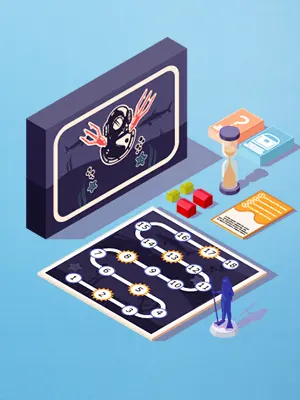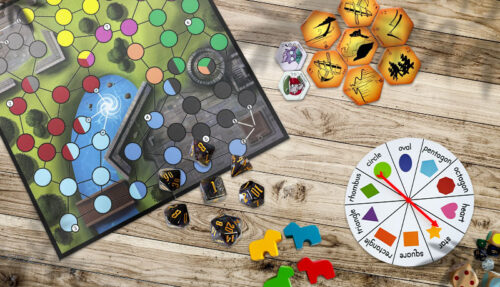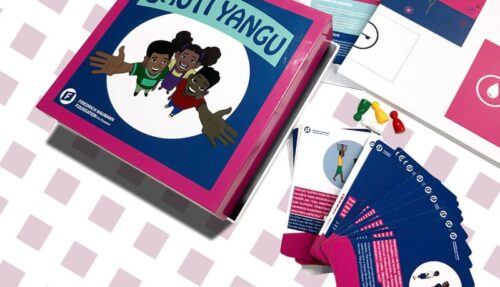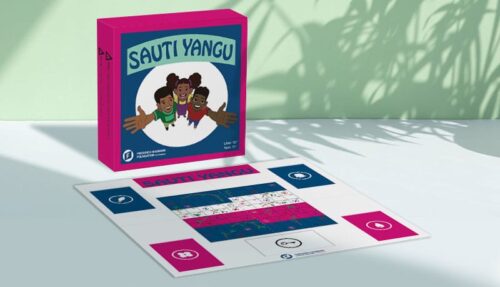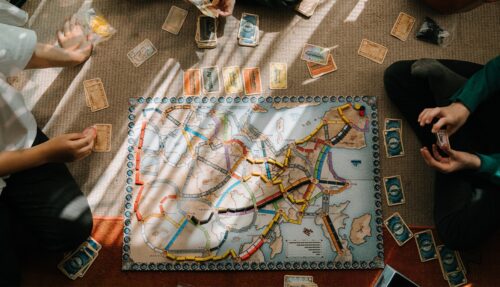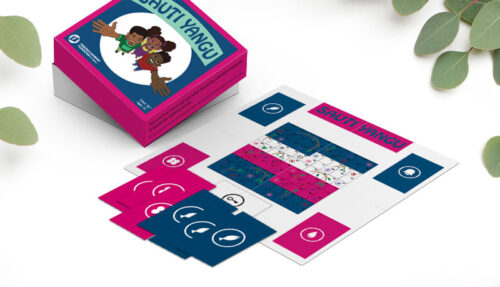We explore the best techniques for developing an idea for a board game and then taking that idea from concept to creation of a prototype and eventual publication of your game
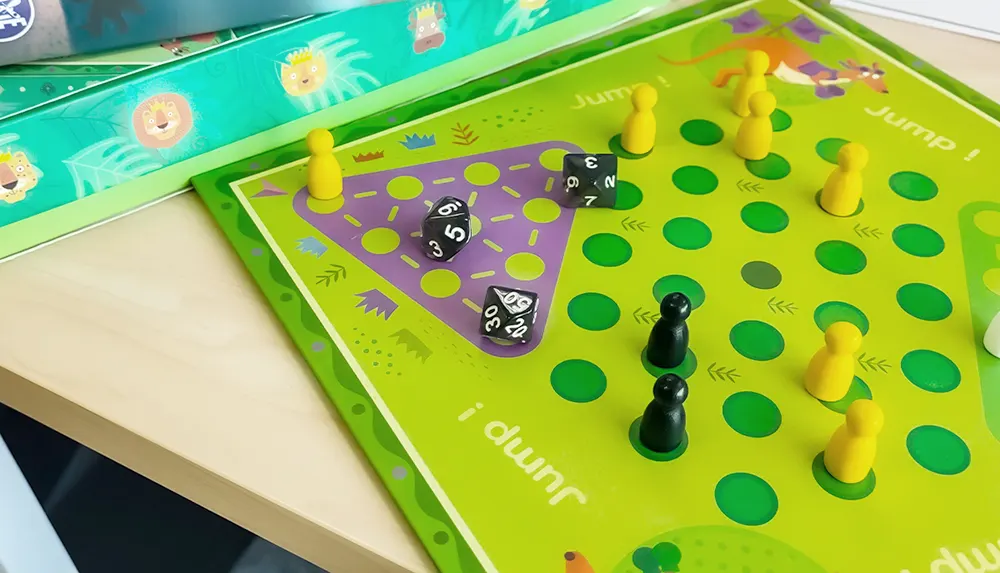
Creating a unique and engaging board game is the key aim of any budding board game designer. However, developing an idea for a board game may not be as easy as you think! One complaint we’ve heard often from board game publishing companies is how many ideas pitched to them are just repeats and variations on pre-existing games. To come up with a truly original board game idea requires creativity, dedication, and a little inside knowledge of the gaming industry. In this post, we’ll be drawing on our 25 years of experience in the board game world to explore various tips and techniques to help you develop an idea for a board game which has a good chance of being functional, fun to play, and appealing to the market.
Where do ideas come from?
Good question! Inspiration for your board game can come from anywhere. You can actively work on developing an idea inspired by a book, a movie, a song, a period in history, an invention, something in the natural world or science, or many other sources. Likewise, an idea can just pop into your head while you’re daydreaming – many professional game designers recommend a lot of daydreaming! – or taking a shower or thinking of something else entirely. But if you’re not sure where to start, here are several helpful suggestions that might spark your creativity:
• Play lots of games
This might seem obvious, but you’d be surprised just how many budding game designers don’t play many games other than their few favorites. But if you want to get into game design, you need to get a broad and deep experience of as many games as you can. The more games you play, the better understanding you will have of different game mechanics, themes, and experiences.
Playing a wide variety of games can also help you recognize what works and what doesn’t, what you like and what you don’t, and also observe other players to measure their reactions to a range of game elements. Don’t forget to include both new and old games, as well as good and bad ones!
• Look for gaps in the market
Assuming you’re not just doing this for fun but have an eye toward publishing or self-publishing and selling your game down the line, while you’re exploring as many games as you can get access to, think about what may be missing. Identify any underserved audiences, group sizes, or game dynamics that could benefit from a new board game. For example, consider creating games for solo players—an increasingly popular trend at the time of writing – or for large groups, or children with learning disabilities, for example.
When Elizabeth Hargreave first came up with the idea of a board game for ornithologists and birdwatchers, many people thought she was barking up the wrong tree. But Stonemaier Games picked up her game – Wingspan – and it has really, pardon the pun, taken off. If you can find a gap in the market, however whacky the idea may seem, you’re probably onto a winner.
• Explore beyond games
As we said at the start, ideas can spring up from anywhere. While playing a lot of games in vital, you should also extend your explorations into other niches and sectors. Other forms of entertainment, such as video games, movies, comics, graphic novels, books, and music, can provide valuable inspirations for board game design. So, watch a lot of movies, read a lot of novels and comics, and play video games, too.
• See things from a different perspective
Another powerful technique for coming up with original ideas is to shake things up a bit and try to see things from a new perspective. In literature, the figure of the vampire had all but died out until Joss Whedon came up with the idea for a TV show and comic books about a young woman who gets romantically involved with a vampire who’s trying to rediscover his soul (Buffy the Vampire Slayer). That new twist not only revived the genre but spawned a whole new industry.
So with games, try flipping ideas out in unexpected ways. Allow players to take on unconventional roles in your game, such as a villain or monster. This can create unique and exciting experiences for players and help your game idea find an original and unique expression.
Brainstorm and develop your idea
Once you’ve found a point of inspiration, it’s essential to brainstorm and refine your game ideas. There’s no escaping the fact that a good idea alone won’t be enough to make your game a success. Inspiration is only the first step. Once you have a good idea, that’s when the work really begins. So, don’t just take your idea at face value. Explore it, expand on it, test it. Let’s look at several techniques to help you develop your game concept from the initial idea.
Write everything down
All successful game designers keep notebooks. It doesn’t matter if it’s an old-fashioned pocketbook and pencil or an app on your smartphone. The important thing is to jot down all your ideas, even the craziest ones. You never know which idea could lead to something special. The other reason is that you’ll probably find that you come up with way more than one idea. You might think you’ll remember everything, but we can all but guarantee you won’t. Have you never had a great idea come to you in the middle of the night and you can’t remember it in the morning? Or inspiration strikes while you’re riding the bus to work, but when you get home you’ve forgotten the important details? Keeping notes, writing everything down makes sure that your ideas never get lost.
Your notebook is also a kind of pocket-sized workshop. You can snatch odd moments here-and-there throughout the day to use it to develop your ideas, scribble sketches, and work on your game. Finding dedicated time for game development around work, family, and other commitments is often a challenge. Keeping a notebook with you at all times means you can capitalize on any free time you get – waiting in line, riding public transit, going to the bathroom – to work on your game ideas.
Define your game's core elements
Working from your notes, it’s essential to establish the fundamental aspects of your game, such as target audience, player experience, and game mechanics. Answering the following questions can help you define these core elements:
- Who is the game for? (age, background, interests, etc.)
- How should the players feel? (excited, puzzled, challenged, intrigued, etc.)
- What makes this game different? (new mechanics, original theme, untapped niche, etc.)
- What are some mechanisms that align with the desired player experience? (turns, movement, drafting, collecting, combat, time limits, etc.)
- What are players trying to accomplish, and how do they win? (area control, destination, points, sets, etc.)
- What player count and playtime should the game have? (solo, small group, family, large group, one hour, three hours, more than one session to complete, etc.)
These are all important questions to answer to both develop your board game idea and to test its viability. You’ll probably come up with other questions, too. But these should be enough to get you started in the right direction.
Experiment with theme, mechanisms, and game experience
There’s no one-size-fits-all approach to designing a game. Some designers start with the theme, others with mechanics, and some focus on the overall player experience. Whichever way you work, you’ll need to take your idea from a raw concept to a fleshed out design. So, you’ll need to translate it into a clear thematic context, work out a win condition, figure out the way the game will play, how many players there can be at one time, the mechanics, components, rules, and more. Never just settle for the first thing that comes to mind. Experiment with distinct possibilities to find the approach that works best for you and your game.
Playtest a minimum viable product (MVP) version
An MVP is the simplest version of your game idea. Before you can really tell if you have something that’s ready to transfer to the next stage of print and production, you need to playtest a basic, low-cost version. That’s your MVP: a version which you make at as little cost as possible while still producing a playable game. Most times you can knock this up at home using cardboard, paper, colored pens, scissors, sticky tape and old toys like plastic soldiers or other items as stand-ins for figurines and miniatures. You can hijack dice, counters, and other bits from other games you already own. You get the idea. It won’t look pretty, but that’s not the idea. It just has to work.
Playtesting is crucial to identify any issues with your idea and make improvements to your game. Gather feedback from a diverse group of playtesters– family and friends, the guys at your local game night, an independent game store with play tables, testers at conventions –to make sure that your game idea holds up. You want your game to be enjoyable and provide a balanced experience for all the players.
Listen to playtesters’ feedback and be prepared to change your game based on their suggestions. Make notes – back to your handy notebook! – and address any elements that detract from the fun or create unfair advantages or disadvantages. Take nothing personally. Remember that playtesting is a crucial part of the game idea development process, and constructive criticism can help you create a better game.
Talk to us!
We hope that’s helped you on the way to discovering your best unique board game ideas and given you useful strategies for developing and testing those ideas. If you feel you’re ready to dive deep, then read, How to Design a Professional Board Game: The Complete Guide for Beginners. It’s a long-form, in-depth post that covers every aspect of board game design and development. Book mark it and come back to it several times as you work through it. It will save you a lot of money in expensive books and courses, too!
When you’re ready to print your board game and manufacture your components, talk to us. We’ve got over 25 years’ experience in the industry, helping independent creatives just like you to realize their dreams. It’s free to talk and when you’re ready we’ll give you a no-obligation quote on the work, so that you know upfront exactly what’s involved. We can’t wait to work with you!



